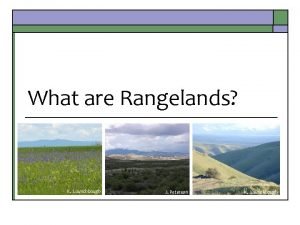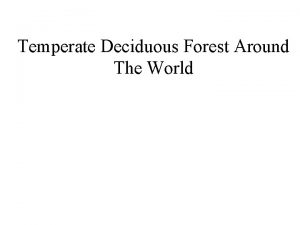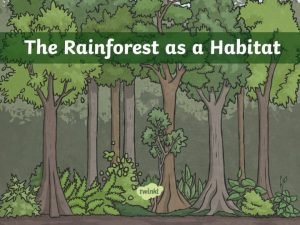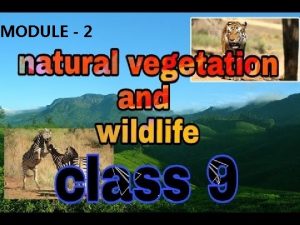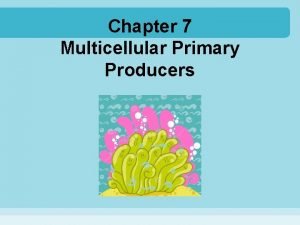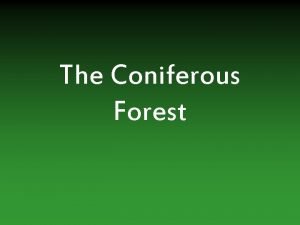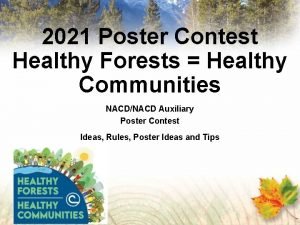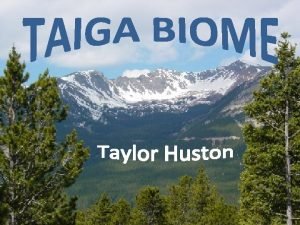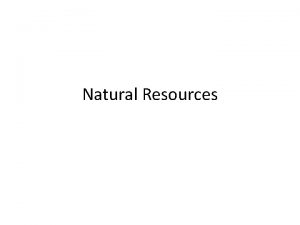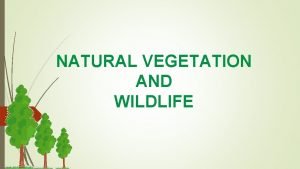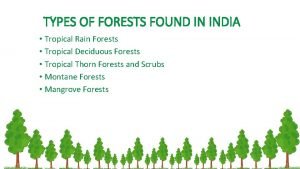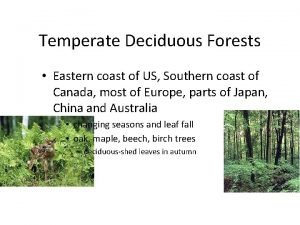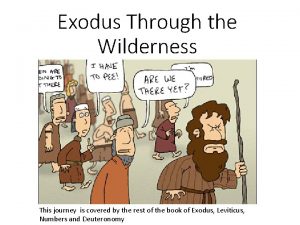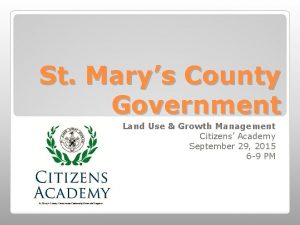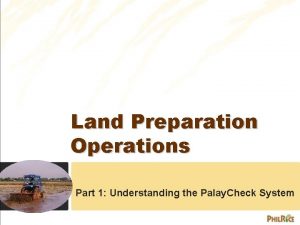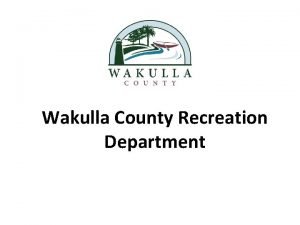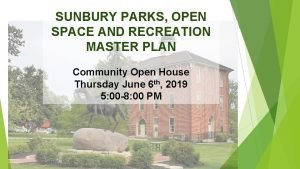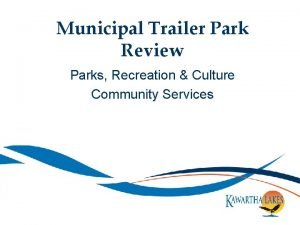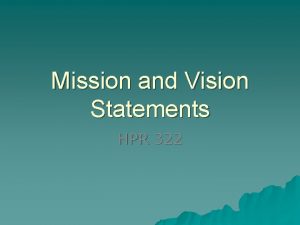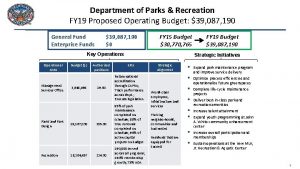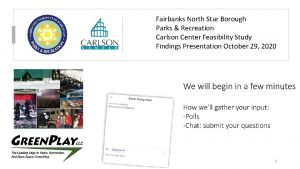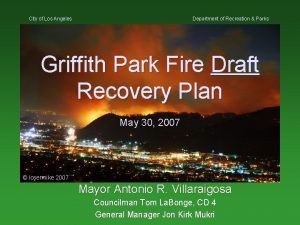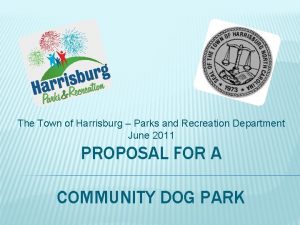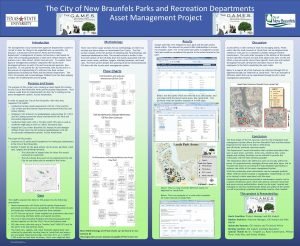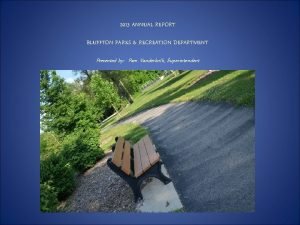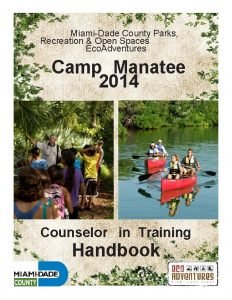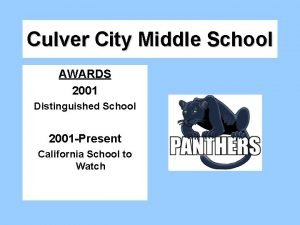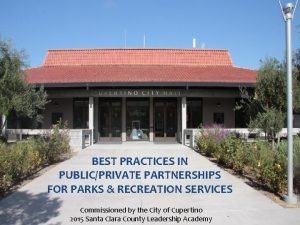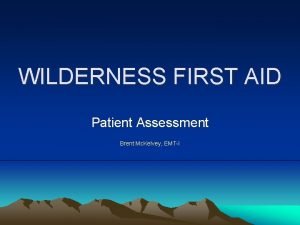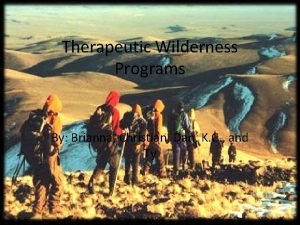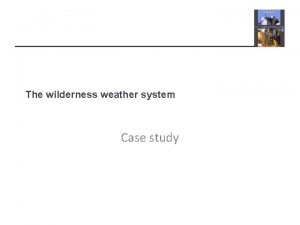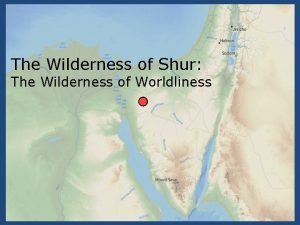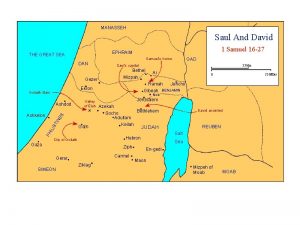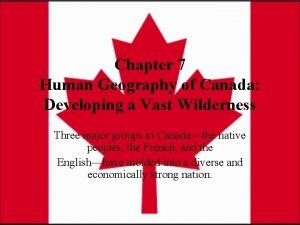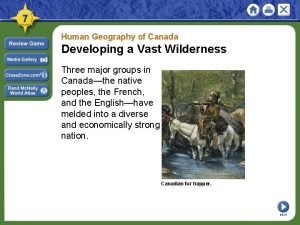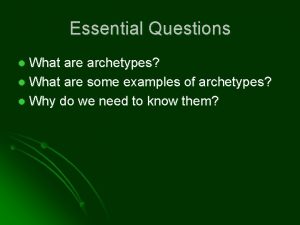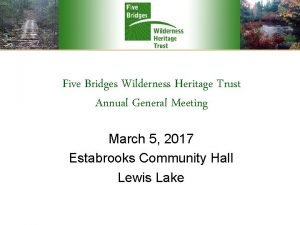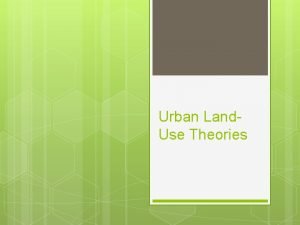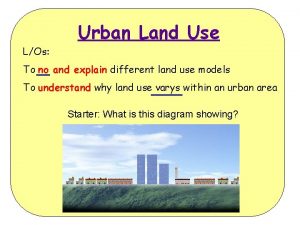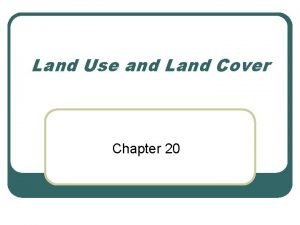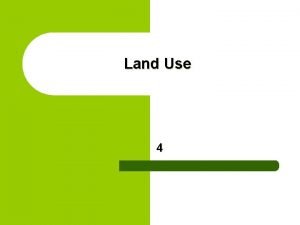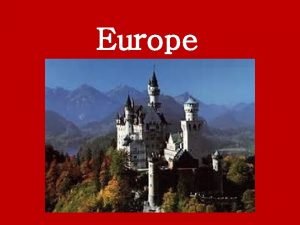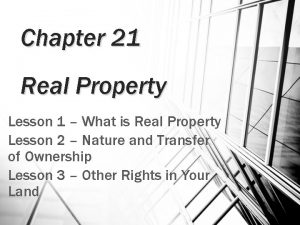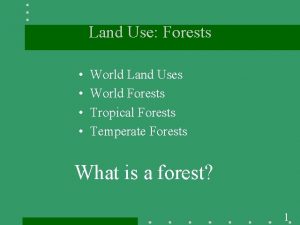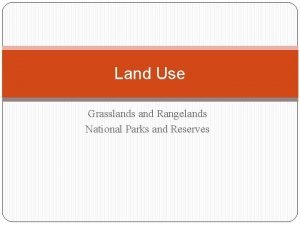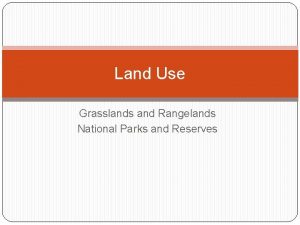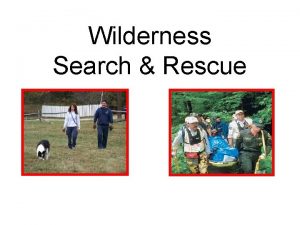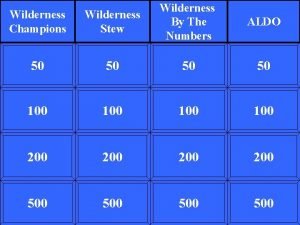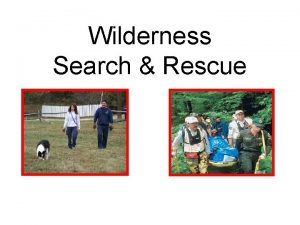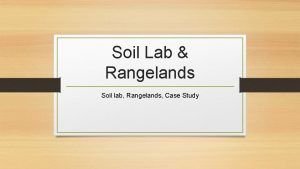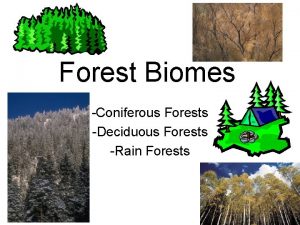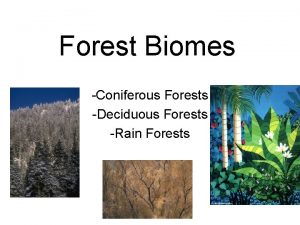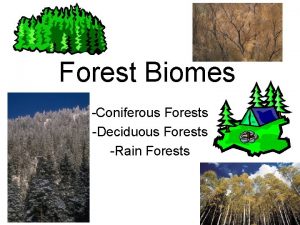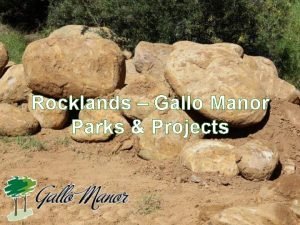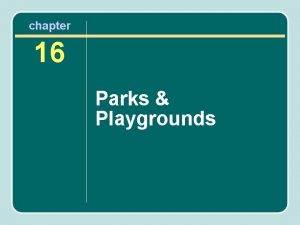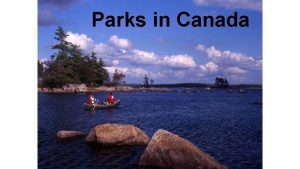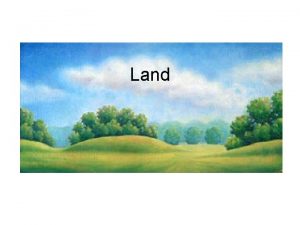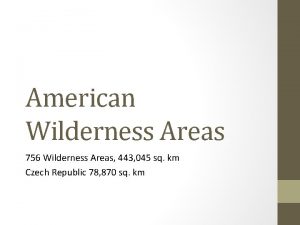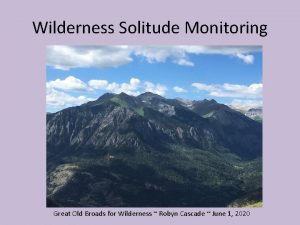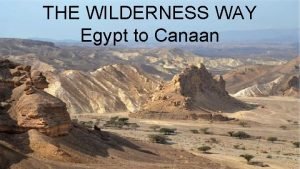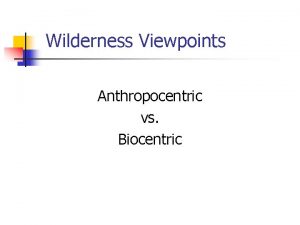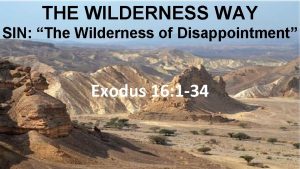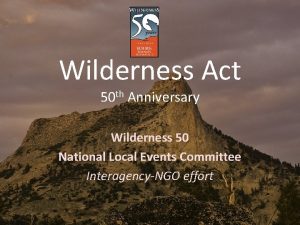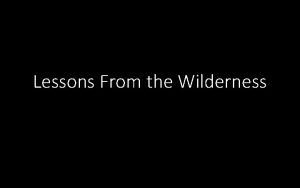Land Use Forests Rangelands Parks and Wilderness World





































































- Slides: 69

Land Use: Forests, Rangelands, Parks and Wilderness

World Land Use

Measuring forest cover • A 2001 international study used GIS with satellite data to put together an accurate inventory and map of the world’s forest cover. • 20% of Earth’s surface remains covered by closed forest. • 88% of this is sparsely inhabited by people. • 80% is concentrated in just 15 nations. From The Science behind the Stories

Timber harvesting • Most timber harvesting in the U. S. takes place on private land, especially land owned by timber companies. • But much takes place on public land—national forests. • The U. S. National Forest system was established at the turn of the last century, and the Forest Service manages forests for sustainable timber yield, and, increasingly, recreation and ecosystem health.

Deforestation • Over 3 centuries, Americans denuded most of their forests (green). 1620 1920 Even in the green areas mapped above, very few large virgin trees remained; nearly all forest is second growth. Figure 16. 9

Federal lands • U. S. federal agencies own a large amount of land in the western U. S. , allowing resource extraction on most of it. National forests = green Figure 16. 10

Federal Lands • 3 Categories – Multiple Use Lands – Moderately – Restricted Use Lands • Categories are important

Types of Protected Lands in U. S. • Multiple-use lands – National Forest System (NFS) • 156 Forests & 19 Grasslands • Management concept – sustainable yield • multiple use – used for logging, mining, grazing, farming, oil, recreation, hunting and conservation • Mission of NFS – Achieve quality land management under sustainable multiple-use management concept to meet the diverse needs of people • Website: USDA Forest Service: www. fs. fed. us

Wayne National Forest

Natural Resource Lands. Multiple- Use Lands – Bureau of Land Management (BLM) • Grasslands, Prairies, Desersts, Scrub Forests, and Open space • mostly in Western US and Alaska • multiple use • used for mineral and oil extraction/ grazing – “secure domestic supply of energy and strategic minerals” • Website: http: //www. blm. gov/wo/st/en. html

BLM • • 264 million acres of public lands Agency w/in US Dept. of the Interior Most land in Western 12 states Sustains – Health, diversity and productivity of the public lands for the use and enjoyment of present and future generations

Rangelands • Most ranching takes place on federal land managed by the Bureau of Land Management (BLM)— purple in map. • Grazing fees are extremely cheap. Figure 16. 10

Types of Protected Lands • Moderately Restricted-Use Lands – National Wildlife Refuges (NWR) • 1903 – President Theodore Roosevelt begins system of national wildlife refuges • 552 National Refuges • Over 150 Million Acres • 37 Wetland districts • Managed by US Fish and Wildlife Service • 24% designated as wilderness • protect habitats for – Lodging, grazing, military, oil, farming, hunting, mineral extraction are allowed as long as D of I says OK • Website: http: //www. fws. gov/refuges/

NWR • “To preserve a national network of lands and waters for the conservation and management of fish, wildlife, and plant resources of the US for the benefit of present and future generations. ” – Exec Order 12996, March 25, 1996

NWR • Local Example: – Erie NWR: • In PA – Attracts 237 species of bird: Eagle/Osprey – 47 species of mammals – 27 species of amphibians and reptiles


• National Example: – Arctic National Wildlife Refuges (ANWR) • Nature undisturbed • Pristine land • Primary Mandate of ANWR is to protect the wildlife and habitats of this area for people now and in the future • Website: http: //arctic. fws. gov/

ANWR • Brooks Range • Animals – Porcupine Caribou herd, packs of wolves, hardy muskoxen, lone wolverines, flocks of snow geese, and other wilderness dependent species – 160 bird species, 36 mammals, 9 marine species, 36 types of fish





Undisturbed Ecosystem • Coastal Lagoons, barrier islands, arctic tundra, foothills, mountains and boreal forests provide a range of habitats for the wildlife • Fate of range debated at ALSAKA National Interest Lands Conservation Act (ANILCA-1980) – “Production o foil and gas from the arctic national wildlife refuge is prohibited and no leasing or other development leading to production of oil and gas from the refuge shall be undertaken until authorized by an act of Congress. ”

Types of Protected Lands • Restricted-Use lands – National Park System (NPS) • 54 National Parks and 316 recreation areas, battlefields, memorials, etc. • Preserve and interpret the country’s historic and cultural heritage and protect wilderness areas • Parks: can be used for camping, hiking, fishing and boating • Rec areas: also mining and oil • 49% of National Park system is wilderness

U. S. national parks • 1872 – Yellowstone National Park becomes the world’s first national park: • “a public park or pleasuring-ground for the benefit and enjoyment of the people” • Today, the U. S. national park system includes 388 sites and receives 277 million visits each year. • It is managed by the National Park Service.

Half Dome, Yosemite

Yosemite Valley

Glacier National

Cuyahoga Valley National Park

Me Rock Climbing at Whipps Ledges

NPS Restricted Use Lands • NPS shall promote and regulate the use of the Federal areas known as national parks, monuments, and reservations hereinafer specified, except such as are under the jurisdiction of the Secretary of the Army, as provided by law, by such means and measures as conform to the fundamental purpose of the said parks, monuments, and reservations…

NPS • …which purpose is to conserve the scenery and the natural historic objects and the wild life therein and to provide for the enjoyment of the same in such manner and by such means as will leave them unimpaired for the enjoyment of future generations. – NPS organic act, Aug. 25 th 1916

Yellowstone • Reintroduced wolves into Yellowstone, is this compatible with the mission of the park?


Types of Protected Lands • Restricted-Use lands – National Wilderness Preservation System (NPS, USFWS, USFS) • 1964 – Congress passes Wilderness Act • 474 roadless areas in National Parks, wildlife refuges and national forests • Are preserved untouched for everyone to enjoy later • used for hiking, fishing, camping, non-motorized boating, hunting, horseback riding • roads, grazing, mining, buildings are prohibited

Wilderness areas “To assure that an increasing population…does not occupy and modify all areas … leaving no lands designated for preservation and protection in their natural condition. ” —U. S. Congress Figure 16. 18

Locations of Parks, Preserves, Forests and Refuges

What it boils down to… • NFS: – Multiple Use Land • Lumber, cattle, people, ect – Dept of Agriculture • National Park – Owned by gov’t. – Preservation for future • “unimpaired for future generations” – Most don’t allow hunting unless – Dept of Interior

More… • Wilderness Area – Preservation – No roads/structures/(most)motorized equ. more pristine – Most allow hunting – Can be within NF, NP and Refuges! • Wildlife Refuge – Most don’t allow hunting – Greater protection from gov’t. than NF

Forest Management • Most of the world’s forests are managed for paper and wood production • Paper production uses short rotation • Old-growth wood for furniture requires long rotation

Types of Forest Management • Even-aged management – forest is cut down, and regrowth trees are maintained at the same size and age – monoculture – industrial forestry – high industrial productivity low biodiversity

Types of Forest Management • Uneven-aged management – variety of tree species are maintained at different sizes and ages – fosters natural regeneration – high diversity – long term production of high quality timber • Strategy decision is based upon return timetable of money required


Tree Harvesting

If you were a trying to cut the trees in a forest, what strategy would you employ? u u u

Strategy 1: Selective Cutting intermediate-aged or old trees are cut maintains unevenaged stand industry people say it is not profitable can be destructive because many trees can be killed by removing a few large ones


Shelterwood Cutting mature trees are removed in 2 -3 cuts leaving even aged stand, over 10 -15 years Done to allow growth of shade tolerant trees Hardwood forests need shade as saplings natural looking forest that can be used for recreation can be a good habitat for wildlife Trees left can be wind damaged not recommended for trees with shallow roots Strategy 2:



Strategy 3: Seed-tree Cutting harvests most of a stand’s trees in one cutting leaves a few remaining trees to re-seed the site after new trees are established, remaining adults are taken allows several species good for wildlife and recreation

Strategy 4: Clear-cutting Like a Hurricane hit land or natural disaster Mostly occurs in Pine forests, which require full sunlight to grow all trees are removed at once site is artificially re-seeded requires less money, skill high return eliminates recreational and wildlife use Done to take unhealthy lot to healthy

Alaska


Strategy 5: Strip cutting a strip of trees is removed that is narrow enough to be naturally re-seeded the next year, a new strip is cut; etc. forest is clear-cut over a decade or so will much less damage

Strategy 5: Whole-tree harvesting the entire tree, including roots are brought to plants and chopped into wood chips most destructive methods, because it removes all plants material and most associated organisms removes nutrients from soil

How are fires important in forest management?

Management forest fires • Fire policy has posed a particular challenge forest management. • Fire is a natural phenomenon that can renew forests. • But decades of human fire suppression allowed lots of combustible debris to accumulate in forests. Figure 16. 14

Fires • Pros – many plant species require fires for seedling generation – destruction of old trees, providing light gaps, encourages growth of young trees – regrowth provides food for herbivores

Fires • Cons – can be destructive to huge plots of land animal plant species – can threaten structures – can accelerate erosion

Fire Policy • Prevention, Prescribed burns, Suppression • Historically, all fires have been suppressed – this caused the build-up of dead plant material – when fires erupted they were severe – all pros were killed • Since 1972 most natural fires have been allowed to burn – natural process of regeneration – Yellowstone fires is causing people to think about reversing the policy

Threats to forests • Pathogens and insects • Air pollution and Climate Change • Harvesting – wood • although per capita wood use is less, population is growing faster than decrease • regulations greatly support logging – but, forests are generally healthier than they have been – Sustainable Forestry!! HULU VIDEO

Managing Rangelands • Definition – lands that provide foraging material for grazing animals – usually in areas to dry for irrigation – 42% is used for grazing livestock – 34% of U. S. land is rangeland • 84% of mammals species • 74% of bird species – Threats • overgrazing, destruction to riparian habitats • huge subsidies • read about coyotes and sheep

Managing National Parks • Established in the U. S. in 1912, most in West • Threats – not enough money to maintain them – many are too small to support large species – increased people visiting parks (500 mil by 2010) – non-native species brought in – human activities on adjacent lands – air pollution • To do: – use all fees for management – refocus attention on preserving habitat • read about everglades

Managing Other Wilderness Areas • Definition – areas that are undisturbed by humans activities – should be at least 1, 500 square miles • so that it is not affected by pollution, drilling, forestry and urban development – 34% of the earth’s surface • 30% of them are forests • only 20% are protected

Wilderness Areas

Solutions: Biosphere reserves • Core area - no disturbance • buffer zone - managed activities • transition zone - sustainable forestry and conservation

Why create parks, reserves, and wildlands? • Why set aside land voluntarily refrain from developing and exploiting its resources? – • To protect enormous, beautiful, unusual landscape features (monumentalism) – • To make use of sites that have little economic value otherwise – • For utilitarian benefits—e. g. , watershed protected for drinking supply – • For recreational use for outdoors activities – • To preserve biodiversity

Ppt Adapted From • Jay Withgott: 2005 Pearson Education Inc. , publishing Benjamin Cummings • http: //www. orange. k 12. oh. us/teachers/ohs/js angdahl/
 What are rangelands?
What are rangelands? Temperate forest average precipitation
Temperate forest average precipitation Very dense warm and wet forest
Very dense warm and wet forest Tropical thorn forests and scrubs
Tropical thorn forests and scrubs What are landforms
What are landforms What are landforms
What are landforms Vrindavan forest name
Vrindavan forest name Primary producers in kelp forests
Primary producers in kelp forests Deciduous forest snakes
Deciduous forest snakes Vast areas of northern coniferous forests
Vast areas of northern coniferous forests Healthy forests healthy communities poster contest
Healthy forests healthy communities poster contest Define coniferous forest
Define coniferous forest Materials or substances such as minerals forests
Materials or substances such as minerals forests What is natural vegetation
What is natural vegetation Tropical thorn forest and scrubs
Tropical thorn forest and scrubs Characteristics of temperate deciduous forest
Characteristics of temperate deciduous forest Age structure diagram definition apes
Age structure diagram definition apes Exodus journey map
Exodus journey map St. marys county land use and zoning lawyer
St. marys county land use and zoning lawyer Land preparation activities
Land preparation activities Wakulla rec park soccer
Wakulla rec park soccer Parks sunbury
Parks sunbury Parks and recreation trailer
Parks and recreation trailer Parks and recreation vision statement examples
Parks and recreation vision statement examples Parks and recreation organizational chart
Parks and recreation organizational chart Carlson center fairbanks events
Carlson center fairbanks events City of los angeles department of recreation and parks
City of los angeles department of recreation and parks Tvs ilp
Tvs ilp Harrisburg park and rec
Harrisburg park and rec New braunfels parks and recreation
New braunfels parks and recreation Bluffton parks and recreation
Bluffton parks and recreation New braunfels gis
New braunfels gis Eco adventures miami
Eco adventures miami Jessamine county parks and rec
Jessamine county parks and rec Fayetteville cumberland parks and recreation
Fayetteville cumberland parks and recreation Culver city parks and recreation after school program
Culver city parks and recreation after school program Long beach parks and recreation
Long beach parks and recreation Cupertino parks and rec
Cupertino parks and rec First aid patient assessment
First aid patient assessment Sagewalk wilderness therapy camp
Sagewalk wilderness therapy camp A wilderness weather station case study
A wilderness weather station case study The wilderness of shur
The wilderness of shur Ziph
Ziph Wilderness of ziph
Wilderness of ziph Unfaithful wife archetype examples
Unfaithful wife archetype examples Supernatural intervention archetype
Supernatural intervention archetype Wilderness weather station case study
Wilderness weather station case study Canada wilderness
Canada wilderness Innate wisdom vs. educated stupidity examples
Innate wisdom vs. educated stupidity examples Developing a vast wilderness
Developing a vast wilderness Fire vs ice archetype examples
Fire vs ice archetype examples Fire vs ice archetype
Fire vs ice archetype Initiation archetype examples
Initiation archetype examples As moses lifted up the serpent in the wilderness
As moses lifted up the serpent in the wilderness Personal survival kit bsa
Personal survival kit bsa Evil figure with a good heart archetype
Evil figure with a good heart archetype Haven vs wilderness
Haven vs wilderness Command.com
Command.com Five bridges wilderness heritage trust
Five bridges wilderness heritage trust Robotics merit badge requirements
Robotics merit badge requirements Cetacean
Cetacean Holy sector model
Holy sector model Model urban land use
Model urban land use Land use planning '' lecture notes
Land use planning '' lecture notes Hmda land use certificate
Hmda land use certificate Usgs land use classification
Usgs land use classification Types of land use
Types of land use Mixed land use ap human geography definition
Mixed land use ap human geography definition Bid rent theory
Bid rent theory Irrevocable rights to some limited use of another's land
Irrevocable rights to some limited use of another's land
